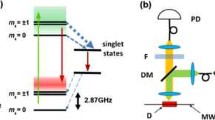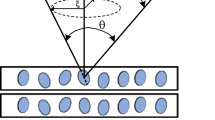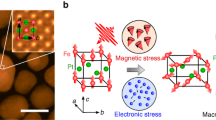Abstract
We report on 1H NMR measurements of spin–lattice and spin–spin relaxation times in hydrogen molecules confined in nanocavities of the a-Si–H thin films. We found that the 1H spin–spin relaxation time T2 and the spin–lattice relaxation times T1 and T1ρ in the laboratory and rotating frames, respectively, exhibit anisotropic behavior as functions of the angle between the film growth direction and the applied magnetic field. This effect is caused by the dipole–dipole interaction of nuclear spins of hydrogen molecules experiencing restricted diffusion in ellipsoid-like nanocavities. The experimental results are analyzed within the framework of the previously developed theory. The analysis allows determining the distribution of nanocavities over orientations in the film under study. Similar phenomena can occur in various materials containing nanocavities and in nanoporous compounds of various origins in which molecular diffusion occurs and to which the above approach is applicable.




Similar content being viewed by others
Data Availability Statement
All data generated or analyzed during this study are included in this article.
References
F. Kail, J. Farjas, P. Roura, P. Roca i Cabarrocas, Molecular hydrogen diffusion in nanostructured amorphous silicon thin films. Phys. Rev. B 80, 073202 (2009)
C. Jeong, S. Boo, M. Jeon, K. Kamisako, characterization of intrinsic a-si: h films prepared by inductively coupled plasma chemical vapor deposition for solar cell applications. J. Nanosci. Nanotechnol. 7, 4169–4173 (2007)
J. Baugh, A. Kleinhammes, D. Han, Q. Wang, Y. Wu, Confinement effect on dipole-dipole interactions in nanofluids. Science 294, 1505–1507 (2001)
G.B. Furman, S.D. Goren, V.M. Meerovich, V.L. Sokolovsky, Correlation of transverse relaxation time with structure of biological tissue. J. Magn. Reson. 270, 7–11 (2016)
G. Furman, V. Meerovich, V. Sokolovsky, Y. Xia, Spin locking in liquid entrapped in nanocavities: application to study connective tissues. J. Magn. Reson. 299, 66–73 (2019)
G. Furman, V. Meerovich, V. Sokolovsky, Y. Xia, Spin-lattice relaxation in liquid entrapped in a nanocavity. J. Magn. Reson. 311, 106669 (2020)
D.L. Williamson, Nanostructure of a-Si: H and related materials by small-angle x-ray scattering. Mat. Res. Soc. Symp. Proc. 377, 251–262 (1995)
X. Xu, J. Yang, S. Guha, Hydrogen dilution effects on a-Si: H and a-SiGe: H materials properties and solar cell performance. J. Non-Crystal. Solids 198–200, 60–64 (1996)
A.H. Mahan, Y. Xu, W. Beyer, J.D. Perkins, M. Vanecek, L.M. Gedvilas, B.P. Nelson, Structural properties of hot wire a–Si: H films deposited at rates in excess of 100 Å/s. J. Appl. Phys. 90, 5038–5047 (2001)
E. Gericke, J. Melskens, R. Wendt, M. Wollgarten, A. Hoell, K. Lips, Quantification of nanoscale density fluctuations in hydrogenated amorphous silicon. Phys. Rev. Lett. 125, 185501 (2020)
M.S. Conradi, R.E. Norberg, Molecular H2: Nuclear-spin-relaxation centers for protons in a-Si:H. Phys. Rev. B 24, 2285–2288 (1981)
W.E. Carlos, P.C. Taylor, Molecular hydrogen in a–Si:H. Phys. Rev. B 25, 1435–1438 (1982)
J.B. Boyce, M. Stutzmann, Orientational ordering and melting of molecular H2 in an a–Si matrix: NMR studies. Phys. Rev. Leltt. 54, 562–565 (1985)
E. Fukushima, S.B.W. Roeder, Experimental pulse NMR, in A nuts and bolts approach. (CRC Press, USA, 1981)
S. Meiboom, D. Gill, Modified spin-echo method for measuring nuclear relaxation times. Rev. Sci. Instrum. 29, 688–691 (1958)
A. Abragam, The Principles of Nuclear Magnetism (Clarendon Press, Oxford, 1961)
A.M. Panich, I.A. Belitskii, N.K. Moroz, S.P. Gabuda, V.A. Drebushchak, Yu.V. Seretkin, Ion and molecular diffusion and order-disorder phase transition in the thallium form of natrolite. J. Struct. Chem. 31, 56–63 (1990)
A.M. Panich, N.A. Sergeev, M. Paczwa, M. Olszewski, 1H NMR study of water molecules confined in nanochannels of mordenite. Solid State Nucl. Magn. Reson 76–77, 24–28 (2016)
A.M. Panich, A.M. Danilenko, S.P. Gabuda, Orientational diffusion and structural mechanism of bromine fluoride (BrF3) intercalation into fluorographite. Akademiia Nauk SSSR, Doklady 281, 389–392 (1985)
A.M. Panich, Nuclear magnetic resonance study of fluorine-graphite intercalation compounds and graphite fluorides. Synth. Met. 100, 169–185 (1999)
N. Wang, Y. Xia, Anisotropic analysis of multi-component T2 and T1r relaxations in Achilles tendon by NMR spectroscopy and microscopic MRI. J. Magn. Reson. Imag. 38, 625–633 (2013)
L.V. Krasnosselskaia, G.D. Fullerton, S.J. Dodd, I.L. Cameron, Water in tendon: orientational analysis of the free induction decay. Magn. Reson. Med. 54, 280–288 (2005)
H. Shao, C. Pauli, S. Li, Y. Ma, A.S. Tadros, A. Kavanaugh, E.Y. Chang, G. Tang, J. Du, Magic angle effect plays a major role in both T1rho and T2 relaxation in articular cartilage. Osteoarthritis Cartilage 25, 2022–2030 (2017)
S. Peto, P. Gillis, Fiber-to-field angle dependence of proton nuclear magnetic relaxation in collagen. Magn. Reson. Imaging 8, 705–712 (1990)
K.I. Momot, J.M. Pope, R.M. Wellard, Anisotropy of spin relaxation of water protons in cartilage and tendon. NMR Biomed. 23, 313–324 (2010)
M. Thommes, C. Schlumberger, Characterization of nanoporous materials. Annu. Rev. Chem. Biomol. Eng. 12, 137–162 (2021)
K. Ji, J. Choi, H. Yang, H. Lee, D. Kim, A study of crystallinity in amorphous Si thin films for silicon heterojunction solar cells. Solar Energy Mater., Solar Cells 95, 203–206 (2011)
S.M. Aldoshin, E.B. Feldman, M.A. Yurishchev, Quantum entanglement in nitrosyl iron complexes. J. Exp. Theor. Phys. 107, 804–811 (2008)
E.B. Fel’dman, A.N. Pyrkov, Evolution of spin entanglement and an entanglement witness in multiple-quantum NMR experiments. JETP Lett. 88, 398–401 (2008)
E.B. Fel’dman, A.N. Pyrkov, A.I. Zenchuk, Solid-state multiple quantum NMR in quantum information processing: exactly solvable models. Philos. Trans. R. Soc. Lond. A 370, 4690 (2012)
S. Tong, Y. Dong, Q. Zhang, D. Elsworth, S. Liu, Quantitative analysis of nanopore structural characteristics of lower paleozoic shale, Chongqing (Southwestern China): combining FIB-SEM and NMR cryoporometry. Energy Fuels 31, 13317–13328 (2017)
Acknowledgements
We are grateful to Profs. J. Baugh and N.A. Sergeev for helpful discussion. This research was supported by a grant from the United States—Israel Binational Science Foundation (BSF), Jerusalem, Israel (No. 2019033), and in part by a R01 grant from the National Institutes of Health (NIH) of the United States (#69047).
Funding
This research was funded by a grant from the United States—Israel Binational Science Foundation (BSF), Jerusalem, Israel (No. 2019033), and by a grant from the National Institutes of Health in the United States (AR 069047).
Author information
Authors and Affiliations
Contributions
All the authors contributed to the concept and design of the study. AMP carried out experiments. GBF, VS, and YX made data processing, compiled a computer program, and took part in the calculations. PRiC grew the films and made their characterization. All the authors read and approved the final version of the manuscript.
Corresponding author
Ethics declarations
Conflict of Interest
All the authors declare no conflict of interest.
Additional information
Publisher's Note
Springer Nature remains neutral with regard to jurisdictional claims in published maps and institutional affiliations.
Rights and permissions
Springer Nature or its licensor (e.g. a society or other partner) holds exclusive rights to this article under a publishing agreement with the author(s) or other rightsholder(s); author self-archiving of the accepted manuscript version of this article is solely governed by the terms of such publishing agreement and applicable law.
About this article
Cite this article
Panich, A.M., Furman, G.B., Sokolovsky, V. et al. Anisotropic Spin–Lattice and Spin–Spin Relaxations in Hydrogen Molecules Trapped in Non-Spherical Nanocavities. Appl Magn Reson 54, 371–381 (2023). https://doi.org/10.1007/s00723-022-01515-6
Received:
Revised:
Accepted:
Published:
Issue Date:
DOI: https://doi.org/10.1007/s00723-022-01515-6




